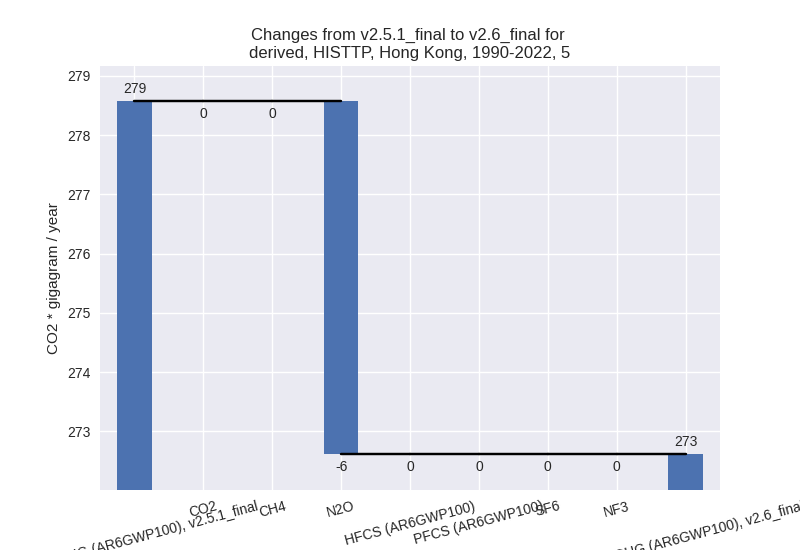Changes in PRIMAP-hist v2.6_final compared to v2.5.1_final for Hong Kong
2024-09-24
Johannes Gütschow
Change analysis for Hong Kong for PRIMAP-hist v2.6_final compared to v2.5.1_final
Overview over emissions by sector and gas
The following figures show the aggregate national total emissions excluding LULUCF AR6GWP100 for the country reported priority scenario. The dotted linesshow the v2.5.1_final data.
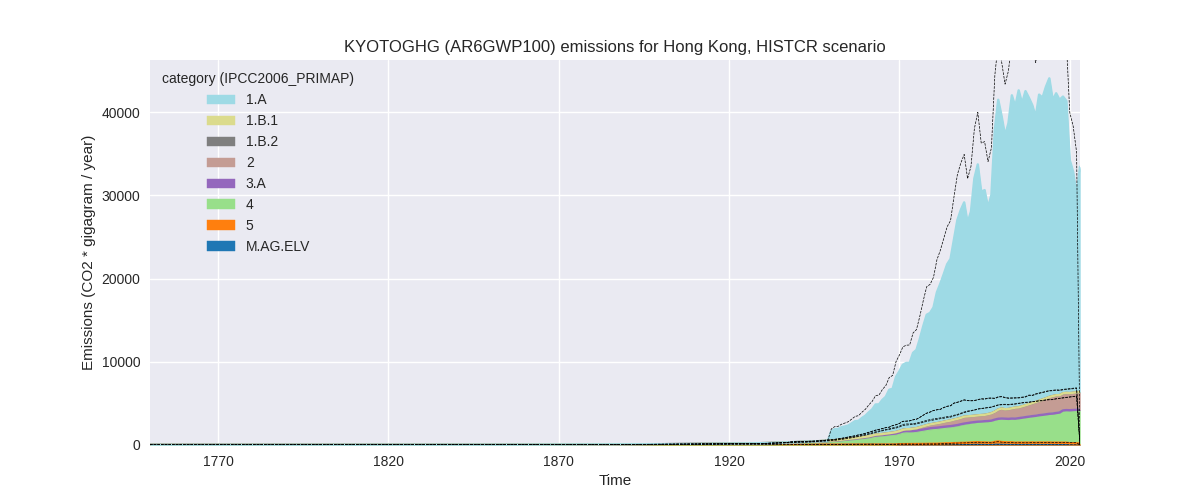
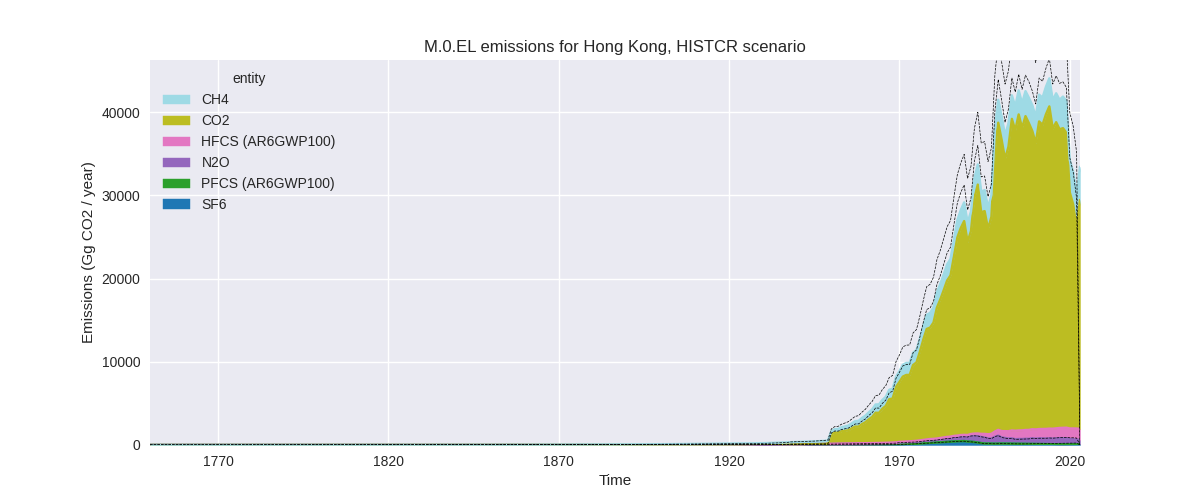
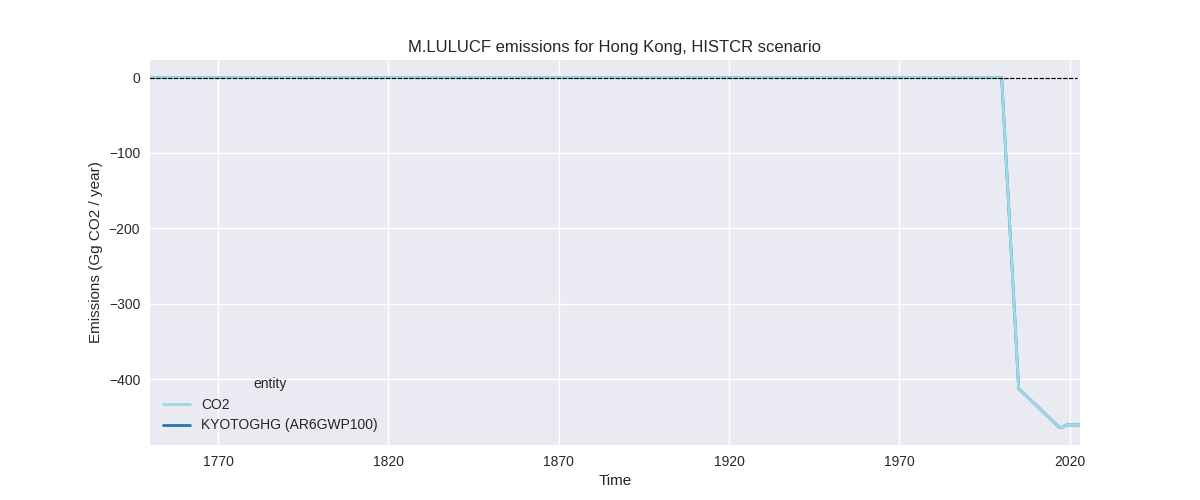
The following figures show the aggregate national total emissions excluding LULUCF AR6GWP100 for the third party priority scenario. The dotted linesshow the v2.5.1_final data.
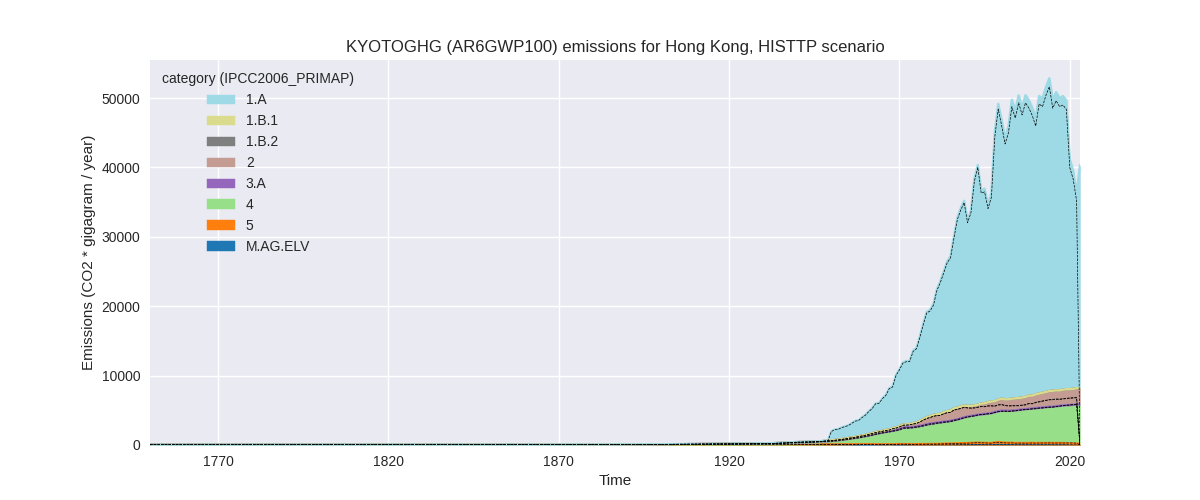


Overview over changes
In the country reported priority scenario we have the following changes for aggregate Kyoto GHG and national total emissions excluding LULUCF (M.0.EL):
- Emissions in 2022 have changed by -14.7%% (-5166.12 Gg CO2 / year)
- Emissions in 1990-2022 have changed by -14.6%% (-6438.58 Gg CO2 / year)
In the third party priority scenario we have the following changes for aggregate Kyoto GHG and national total emissions excluding LULUCF (M.0.EL):
- Emissions in 2022 have changed by 3.0%% (1063.68 Gg CO2 / year)
- Emissions in 1990-2022 have changed by 2.1%% (926.93 Gg CO2 / year)
Most important changes per scenario and time frame
In the country reported priority scenario the following sector-gas combinations have the highest absolute impact on national total KyotoGHG (AR6GWP100) emissions in 2022 (top 5):
- 1: 1.A, CO2 with -4692.08 Gg CO2 / year (-16.7%)
- 2: 4, CH4 with -1588.11 Gg CO2 / year (-29.4%)
- 3: 2, HFCS (AR6GWP100) with 1316.55 Gg CO2 / year (inf%)
- 4: 2, SF6 with -150.84 Gg CO2 / year (-64.3%)
- 5: 5, N2O with -84.85 Gg CO2 / year (-32.7%)
In the country reported priority scenario the following sector-gas combinations have the highest absolute impact on national total KyotoGHG (AR6GWP100) emissions in 1990-2022 (top 5):
- 1: 1.A, CO2 with -5254.34 Gg CO2 / year (-13.9%)
- 2: 4, CH4 with -1706.21 Gg CO2 / year (-37.1%)
- 3: 2, HFCS (AR6GWP100) with 899.57 Gg CO2 / year (inf%)
- 4: 2, CO2 with -377.10 Gg CO2 / year (-51.9%)
- 5: 2, SF6 with -42.70 Gg CO2 / year (-22.0%)
In the third party priority scenario the following sector-gas combinations have the highest absolute impact on national total KyotoGHG (AR6GWP100) emissions in 2022 (top 5):
- 1: 2, HFCS (AR6GWP100) with 1316.55 Gg CO2 / year (inf%)
- 2: 1.A, CO2 with -240.96 Gg CO2 / year (-0.9%)
- 3: 5, N2O with -84.85 Gg CO2 / year (-32.7%)
- 4: 4, N2O with 24.44 Gg CO2 / year (16.1%)
- 5: 2, CO2 with 22.51 Gg CO2 / year (3.2%)
In the third party priority scenario the following sector-gas combinations have the highest absolute impact on national total KyotoGHG (AR6GWP100) emissions in 1990-2022 (top 5):
- 1: 2, HFCS (AR6GWP100) with 899.57 Gg CO2 / year (inf%)
- 2: 4, N2O with 25.97 Gg CO2 / year (23.8%)
- 3: 1.A, CO2 with -8.62 Gg CO2 / year (-0.0%)
- 4: 5, N2O with -5.96 Gg CO2 / year (-2.1%)
- 5: 2, CO2 with 4.78 Gg CO2 / year (0.7%)
Notes on data changes
Here we list notes explaining important emissions changes for the country. ’' means that the following text only applies to the TP time series, while means that it only applies to the CR scenario. Otherwise the note applies to both scenarios.
- We have added country reported data from China’s BUR3 and NC4 and created an independent CR scenario which differs from the TP scenario for most sectors and gases.
- HFCs and PFCs data have been added to the TP scenario from country reported as EDGAR has no HFCs and PFCs data for Hong Kong.
- Changes in sectors 4 and 5 are due to the removal of FAOSTAT data (CR (5 only), TP).
Changes by sector and gas
For each scenario and time frame the changes are displayed for all individual sectors and all individual gases. In the sector plot we use aggregate Kyoto GHGs in AR6GWP100. In the gas plot we usenational total emissions without LULUCF. ## country reported scenario
2022

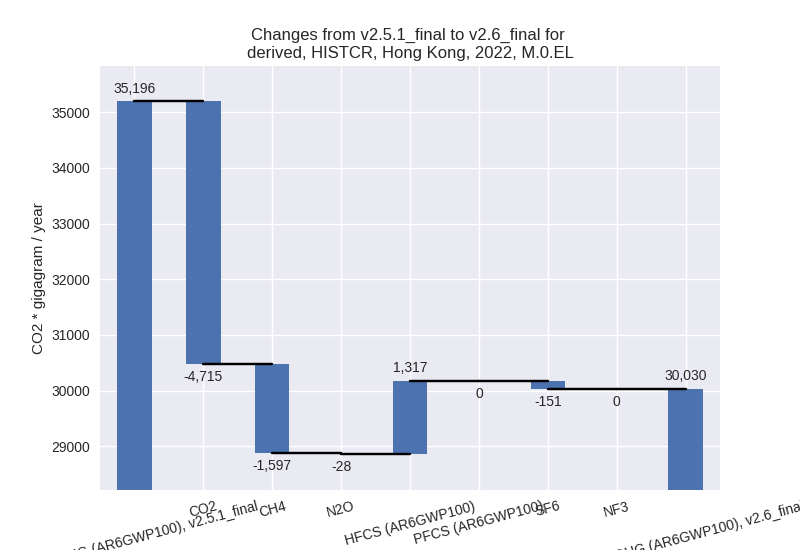
1990-2022


third party scenario
2022
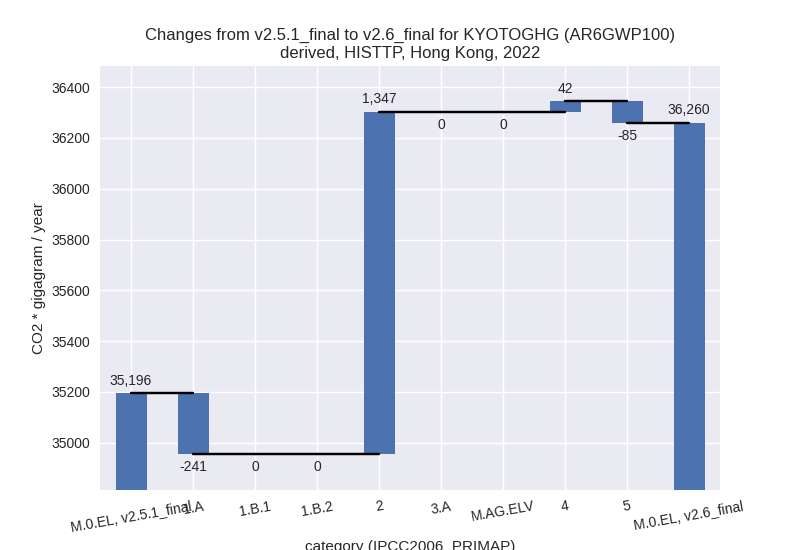
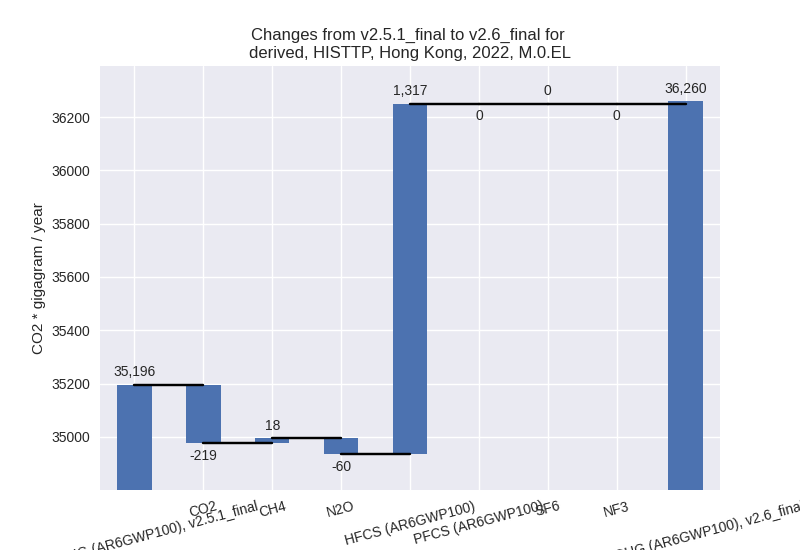
1990-2022

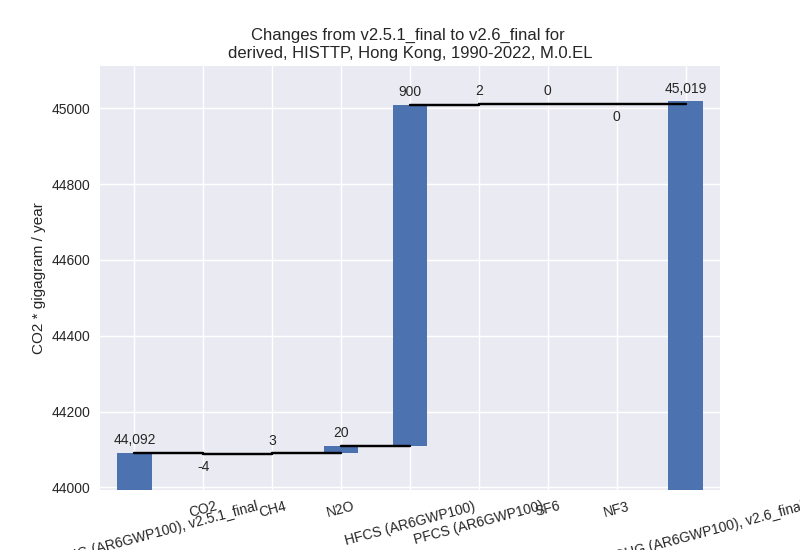
Detailed changes for the scenarios:
country reported scenario (HISTCR):
Most important changes per time frame
For 2022 the following sector-gas combinations have the highest absolute impact on national total KyotoGHG (AR6GWP100) emissions in 2022 (top 5):
- 1: 1.A, CO2 with -4692.08 Gg CO2 / year (-16.7%)
- 2: 4, CH4 with -1588.11 Gg CO2 / year (-29.4%)
- 3: 2, HFCS (AR6GWP100) with 1316.55 Gg CO2 / year (inf%)
- 4: 2, SF6 with -150.84 Gg CO2 / year (-64.3%)
- 5: 5, N2O with -84.85 Gg CO2 / year (-32.7%)
For 1990-2022 the following sector-gas combinations have the highest absolute impact on national total KyotoGHG (AR6GWP100) emissions in 1990-2022 (top 5):
- 1: 1.A, CO2 with -5254.34 Gg CO2 / year (-13.9%)
- 2: 4, CH4 with -1706.21 Gg CO2 / year (-37.1%)
- 3: 2, HFCS (AR6GWP100) with 899.57 Gg CO2 / year (inf%)
- 4: 2, CO2 with -377.10 Gg CO2 / year (-51.9%)
- 5: 2, SF6 with -42.70 Gg CO2 / year (-22.0%)
Changes in the main sectors for aggregate KyotoGHG (AR6GWP100) are
- 1: Total sectoral emissions in 2022 are 23730.65 Gg
CO2 / year which is 79.0% of M.0.EL emissions. 2022 Emissions have
changed by -16.4% (-4656.63 Gg CO2 /
year). 1990-2022 Emissions have changed by -13.8% (-5257.54 Gg CO2 / year). For 2022
the changes per gas
are:
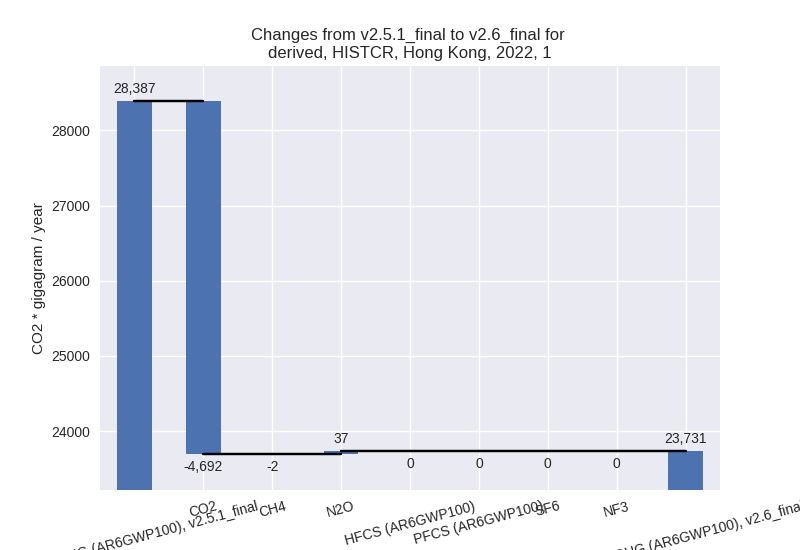
For 1990-2022 the changes per gas are: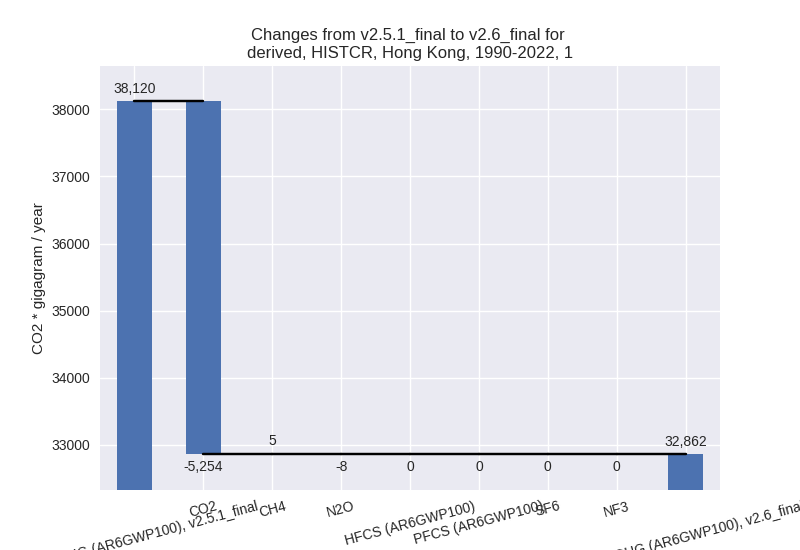
The changes come from the following subsectors:- 1.A: Total sectoral emissions in 2022 are 23691.59
Gg CO2 / year which is 99.8% of category 1 emissions. 2022 Emissions
have changed by -16.4% (-4632.25 Gg
CO2 / year). 1990-2022 Emissions have changed by -13.8% (-5244.83 Gg CO2 / year). For 2022
the changes per gas
are:
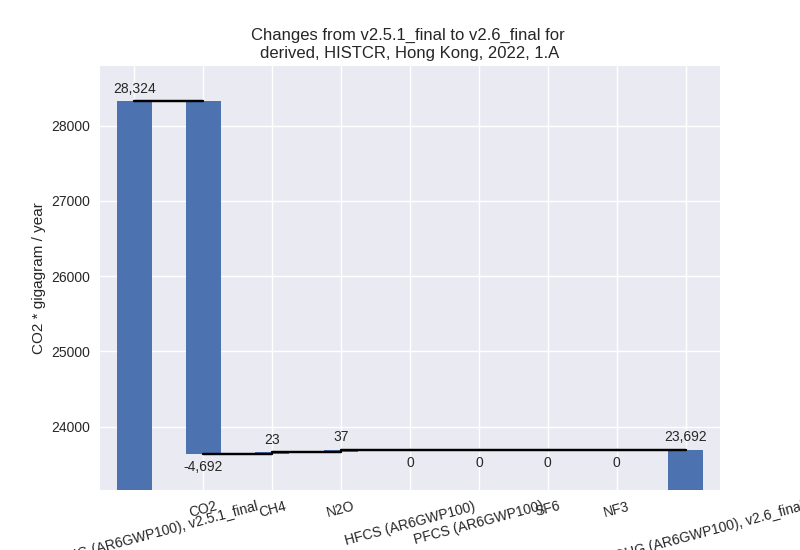
For 1990-2022 the changes per gas are: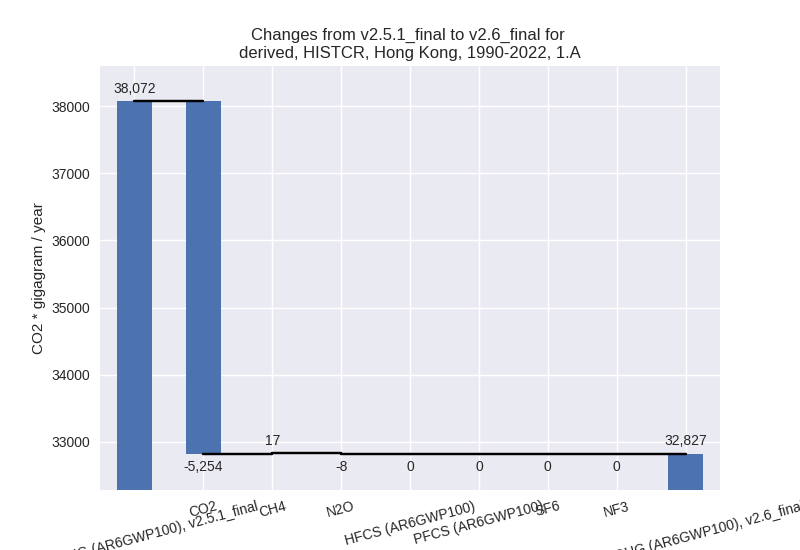
There is no subsector information available in PRIMAP-hist. - 1.B.2: Total sectoral emissions in 2022 are 39.06
Gg CO2 / year which is 0.2% of category 1 emissions. 2022 Emissions have
changed by -38.4% (-24.37 Gg CO2 /
year). 1990-2022 Emissions have changed by -26.6% (-12.71 Gg CO2 / year). For 2022
the changes per gas
are:
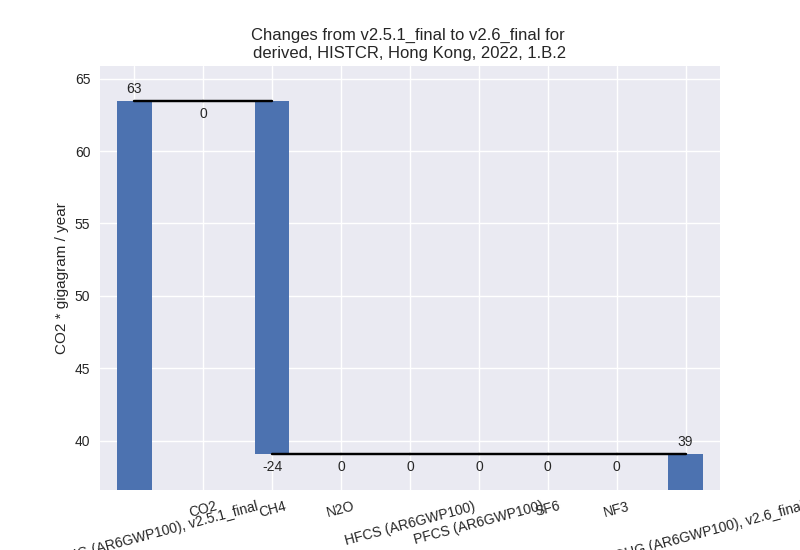
For 1990-2022 the changes per gas are: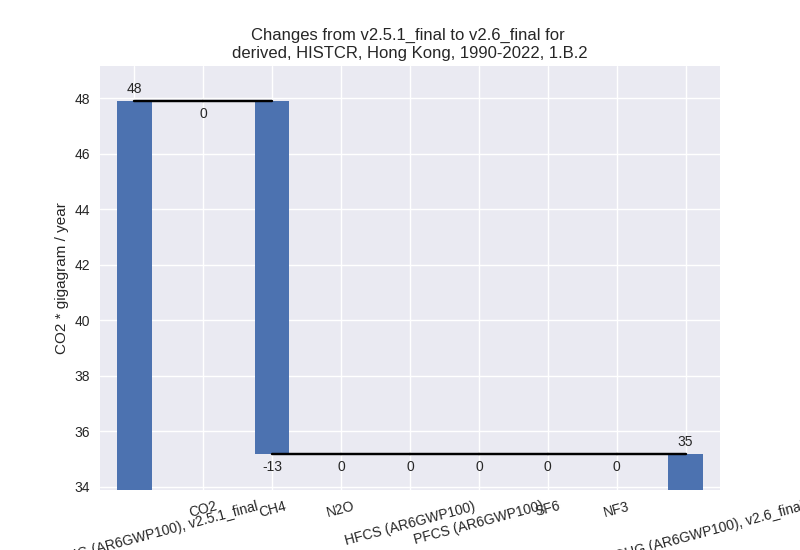
There is no subsector information available in PRIMAP-hist.
- 1.A: Total sectoral emissions in 2022 are 23691.59
Gg CO2 / year which is 99.8% of category 1 emissions. 2022 Emissions
have changed by -16.4% (-4632.25 Gg
CO2 / year). 1990-2022 Emissions have changed by -13.8% (-5244.83 Gg CO2 / year). For 2022
the changes per gas
are:
- 2: Total sectoral emissions in 2022 are 2064.99 Gg
CO2 / year which is 6.9% of M.0.EL emissions. 2022 Emissions have
changed by 121.9% (1134.41 Gg CO2 /
year). 1990-2022 Emissions have changed by 53.4% (488.27 Gg CO2 / year). For 2022 the
changes per gas
are:
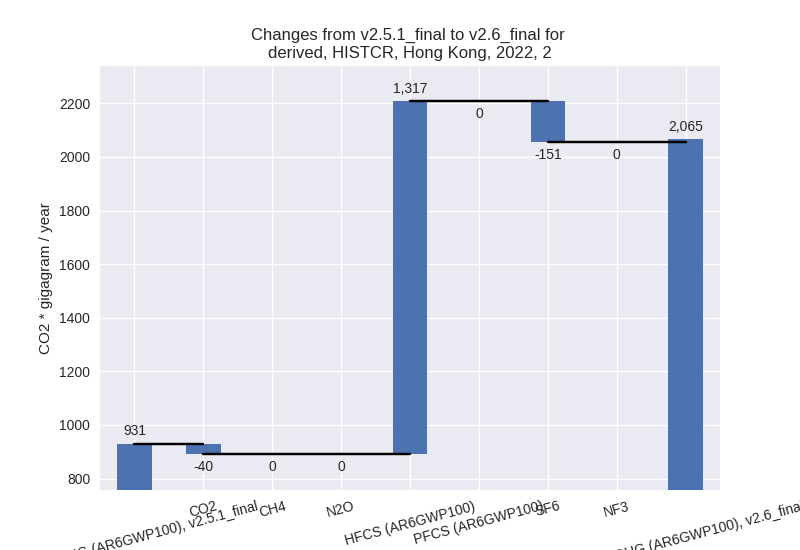
For 1990-2022 the changes per gas are: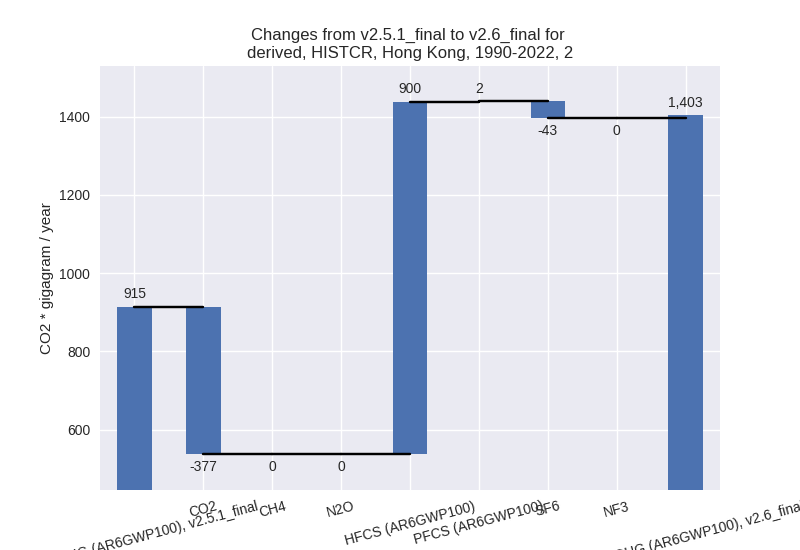
- M.AG: Total sectoral emissions in 2022 are 39.67 Gg
CO2 / year which is 0.1% of M.0.EL emissions. 2022 Emissions have
changed by -16.0% (-7.57 Gg CO2 /
year). 1990-2022 Emissions have changed by 1.8% (0.97 Gg CO2 / year). For 2022 the
changes per gas
are:
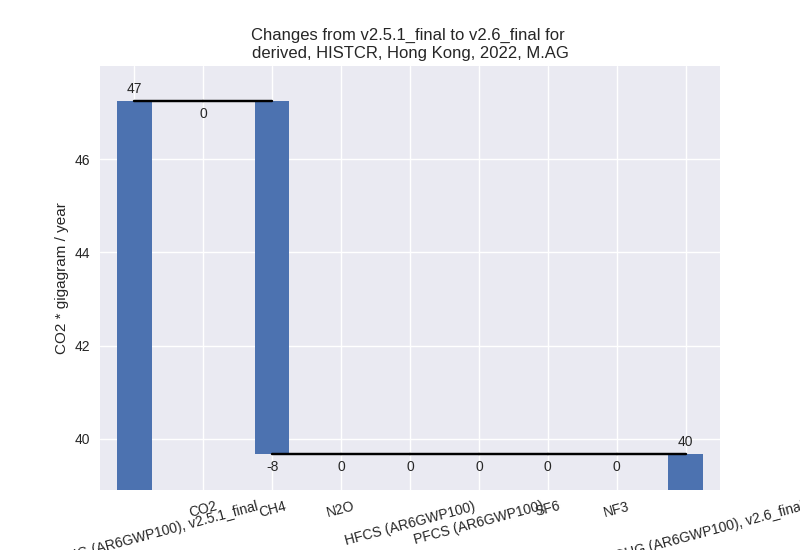
The changes come from the following subsectors:- 3.A: Total sectoral emissions in 2022 are 22.37 Gg
CO2 / year which is 56.4% of category M.AG emissions. 2022 Emissions
have changed by -24.6% (-7.31 Gg CO2
/ year). 1990-2022 Emissions have changed by 3.0% (1.12 Gg CO2 / year). For 2022 the
changes per gas
are:

For 1990-2022 the changes per gas are: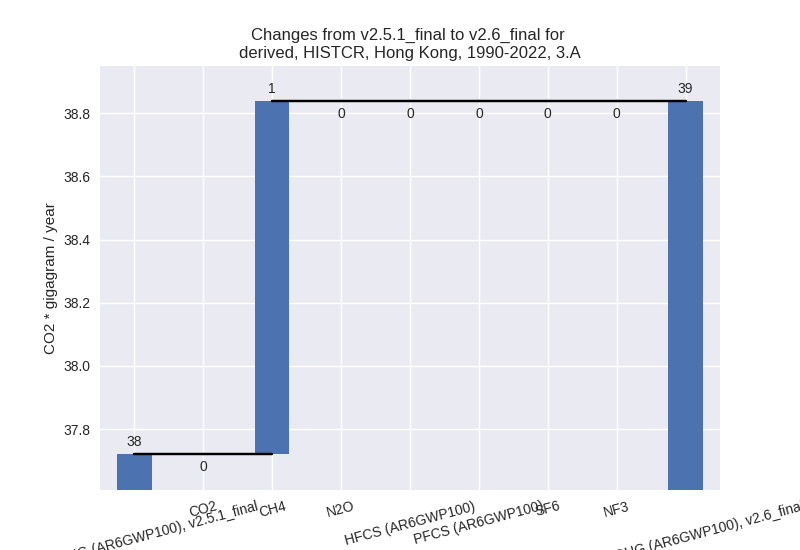
There is no subsector information available in PRIMAP-hist. - M.AG.ELV: Total sectoral emissions in 2022 are 17.30 Gg CO2 / year which is 43.6% of category M.AG emissions. 2022 Emissions have changed by -1.5% (-0.26 Gg CO2 / year). 1990-2022 Emissions have changed by -0.9% (-0.15 Gg CO2 / year).
- 3.A: Total sectoral emissions in 2022 are 22.37 Gg
CO2 / year which is 56.4% of category M.AG emissions. 2022 Emissions
have changed by -24.6% (-7.31 Gg CO2
/ year). 1990-2022 Emissions have changed by 3.0% (1.12 Gg CO2 / year). For 2022 the
changes per gas
are:
- 4: Total sectoral emissions in 2022 are 4019.65 Gg
CO2 / year which is 13.4% of M.0.EL emissions. 2022 Emissions have
changed by -27.8% (-1551.48 Gg CO2 /
year). 1990-2022 Emissions have changed by -35.2% (-1664.32 Gg CO2 / year). For 2022
the changes per gas
are:
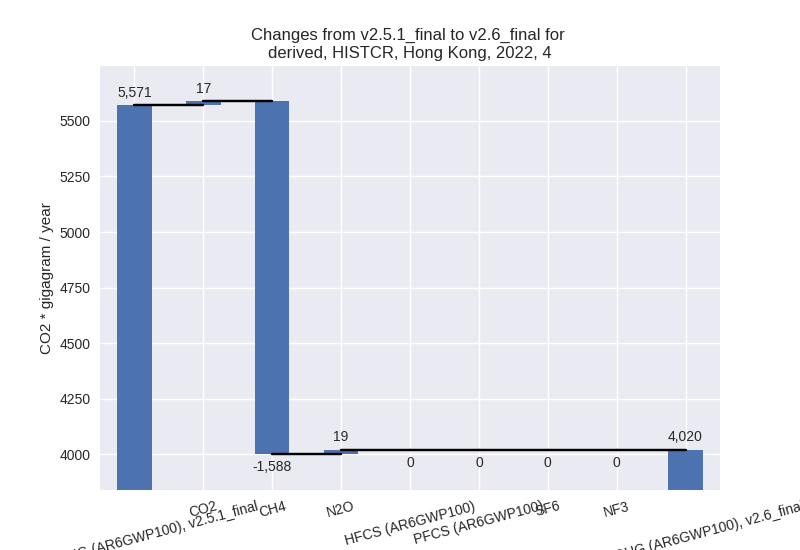
For 1990-2022 the changes per gas are: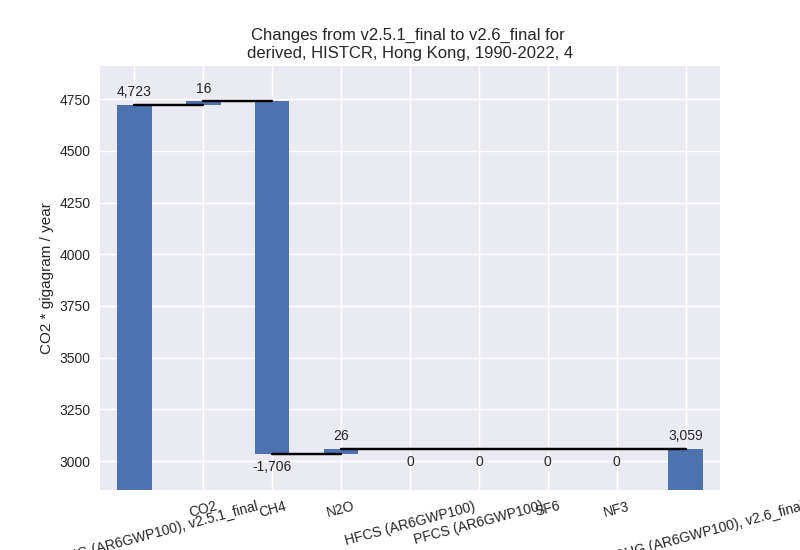
- 5: Total sectoral emissions in 2022 are 174.76 Gg
CO2 / year which is 0.6% of M.0.EL emissions. 2022 Emissions have
changed by -32.7% (-84.85 Gg CO2 /
year). 1990-2022 Emissions have changed by -2.1% (-5.96 Gg CO2 / year). For 2022 the
changes per gas
are:

For 1990-2022 the changes per gas are: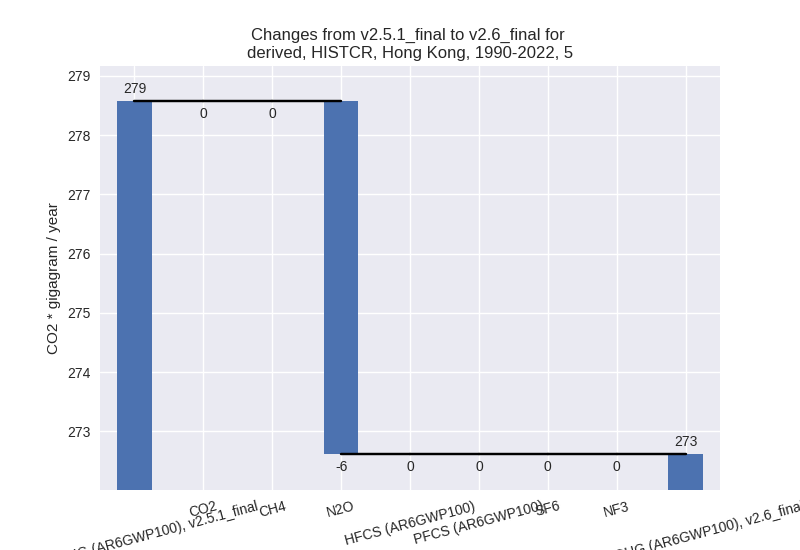
third party scenario (HISTTP):
Most important changes per time frame
For 2022 the following sector-gas combinations have the highest absolute impact on national total KyotoGHG (AR6GWP100) emissions in 2022 (top 5):
- 1: 2, HFCS (AR6GWP100) with 1316.55 Gg CO2 / year (inf%)
- 2: 1.A, CO2 with -240.96 Gg CO2 / year (-0.9%)
- 3: 5, N2O with -84.85 Gg CO2 / year (-32.7%)
- 4: 4, N2O with 24.44 Gg CO2 / year (16.1%)
- 5: 2, CO2 with 22.51 Gg CO2 / year (3.2%)
For 1990-2022 the following sector-gas combinations have the highest absolute impact on national total KyotoGHG (AR6GWP100) emissions in 1990-2022 (top 5):
- 1: 2, HFCS (AR6GWP100) with 899.57 Gg CO2 / year (inf%)
- 2: 4, N2O with 25.97 Gg CO2 / year (23.8%)
- 3: 1.A, CO2 with -8.62 Gg CO2 / year (-0.0%)
- 4: 5, N2O with -5.96 Gg CO2 / year (-2.1%)
- 5: 2, CO2 with 4.78 Gg CO2 / year (0.7%)
Changes in the main sectors for aggregate KyotoGHG (AR6GWP100) are
- 1: Total sectoral emissions in 2022 are 28146.31 Gg CO2 / year which is 77.6% of M.0.EL emissions. 2022 Emissions have changed by -0.8% (-240.96 Gg CO2 / year). 1990-2022 Emissions have changed by -0.0% (-8.62 Gg CO2 / year).
- 2: Total sectoral emissions in 2022 are 2278.06 Gg
CO2 / year which is 6.3% of M.0.EL emissions. 2022 Emissions have
changed by 144.8% (1347.48 Gg CO2 /
year). 1990-2022 Emissions have changed by 99.8% (912.85 Gg CO2 / year). For 2022 the
changes per gas
are:
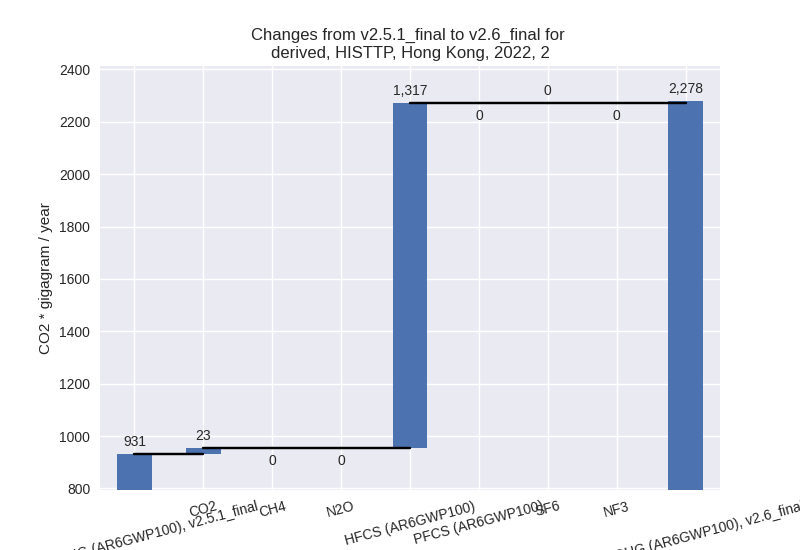
For 1990-2022 the changes per gas are:
- M.AG: Total sectoral emissions in 2022 are 47.24 Gg CO2 / year which is 0.1% of M.0.EL emissions. 2022 Emissions have changed by 0.0% (0.00 Gg CO2 / year). 1990-2022 Emissions have changed by 0.0% (0.00 Gg CO2 / year).
- 4: Total sectoral emissions in 2022 are 5613.14 Gg CO2 / year which is 15.5% of M.0.EL emissions. 2022 Emissions have changed by 0.8% (42.02 Gg CO2 / year). 1990-2022 Emissions have changed by 0.6% (28.65 Gg CO2 / year).
- 5: Total sectoral emissions in 2022 are 174.76 Gg
CO2 / year which is 0.5% of M.0.EL emissions. 2022 Emissions have
changed by -32.7% (-84.85 Gg CO2 /
year). 1990-2022 Emissions have changed by -2.1% (-5.96 Gg CO2 / year). For 2022 the
changes per gas
are:
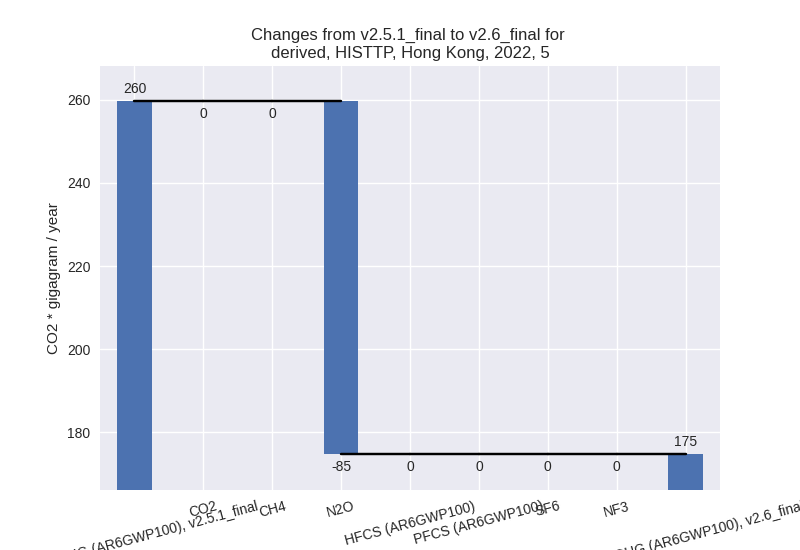
For 1990-2022 the changes per gas are: